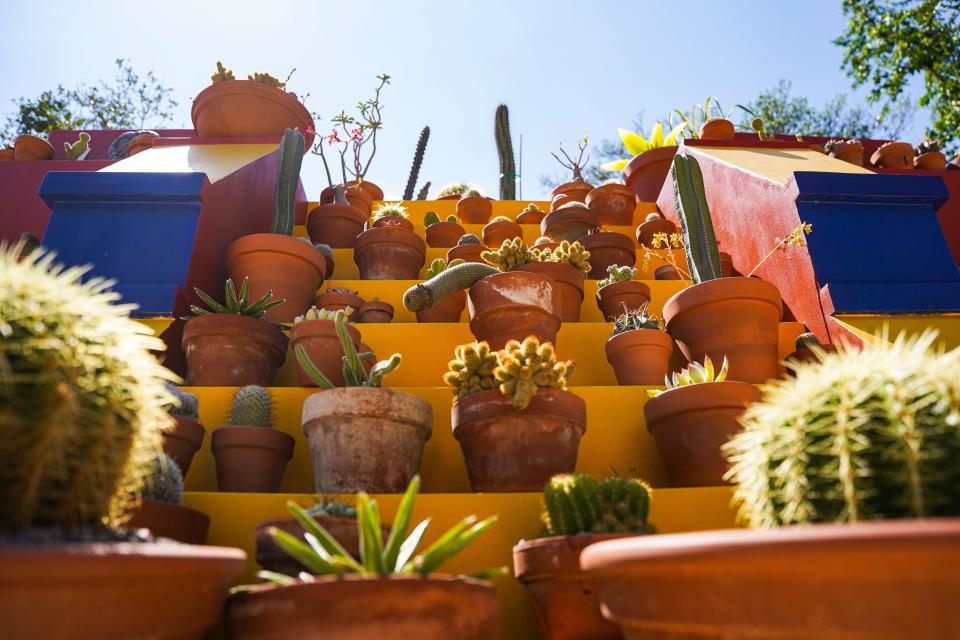Master Gardener: Succulents store water and can be hardy
Succulent plants are enjoying much popularity these days. The word “succulent” is not a scientific term but a descriptive word defined as “fleshy, usually thick and juicy.” Succulent plants have stored water in their tissues which makes them fleshy, thick and juicy! It is noted that there are thousands of cacti and succulent species globally.

According to Gwen Moore Kelaidis, author of "Hardy Succulents," five of the hardier and more common botanical families of succulent plants are as follows:
● Agavacae: Often the members of this family are large plants. Their leaves are sword or spear shaped. Included are yuccas and agaves. The flowers of these plants have six segments each, as do lilies.
● Crassulaceae: Included in this family are the familiar Sempervivum (sedums and Hens and Chicks), Aeonium, Echeveria, Dudleya, and Crassula.
● Mesembryanthaceae: This family includes Living Stones (Lithops) and the Ice Plants.
● Cactaceae: As you may guess, the easily recognized Cacti are members of this family.
● Portulacaceae: Portulaca (or Moss Rose) is a member of this family, and so are some plants that we consider weeds.

In my reading, all sources emphasize how very easy to grow these plants are. Succulents prefer full sun to partial sun exposure. They are happiest in poor, rocky soil and with a minimal amount of water and care. It is better to err on the side of giving too little water rather than too much, at least until you learn the habits of your plants. Don’t they sound like the perfect plants for busy gardeners?
Succulents do not like drought or soggy conditions
They can, however, be killed by intense drought, soggy site conditions and being overshaded by taller plants.
As a child, I was charmed by “Hens and Chicks.” They didn’t resemble any other plants I had ever seen and they grew on and between rocks. I’ve since learned that “Hens and Chicks” is not a particular species, but rather the phrase describes how some Sempervivums and Echeverias reproduce. The plants self-propagate with offsets (sometimes referred to as pups or chicks) surrounding a main plant. The mother plant is the “Hen” and the “Chicks” are the charming little offsets cropping up around the mother plant, connected by a little stem. Aloes, Hawthorias, Agaves, and Gasterias reproduce in this manner, too.
The Genus name Sempervivums comes from the Latin “semper” meaning “forever” and “vivum” meaning “living.” The plants appear to live forever as the chicks continue on as part of the original plant.
The propagation of other succulents is fascinating to observe and it’s fun to watch the plants develop.
My writing here does not begin to scratch the surface of what is interesting about succulents. Much of the information included was gathered from the following sources.
Resources for learning about succulents
Kelaidis, Gwen Moore. “Hardy Succulents, Tough Plants For Every Climate,” Photography by Saxon Holt, Storey Publishing, 11/08
Frank, Gabriel. “Striking Succulent Gardens,” Photography by Dan Kuras, Ten Speed Press, 2021
Smith, Gideon F. “Cacti and Succulents Handbook”, Expanded 2nd Edition, Companion House Books, 2022
Shelf, Ken. “Essential Succulents, The Beginner’s Guide,” Rockridge Press, 2018
Joy Ceraldi is a Master Gardener for Sandusky and Ottawa counties with the Ohio State University Extension Offices.
Want to learn more about plants, soil, pest management, vegetable and fruit production, backyard wildlife, perennials, annuals, bulbs, lawn care, and much more? Master Gardeners have an annual plant sale, educational speakers are available, community gardens for the public, and “ask a Master Gardener” program is available. Watch for information about on upcoming Fall 2024 Master Gardener class. The class is one day a week class for 10 weeks. Details to follow. Visit online at mastergardener.osu.edu or call the extension office at 419-334-6340 to leave a message.
This article originally appeared on Fremont News-Messenger: Gardeners can choose from thousands of cacti and other succulents

